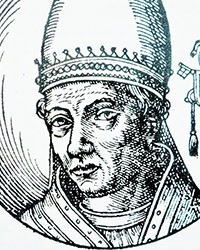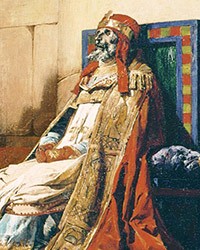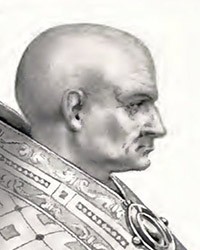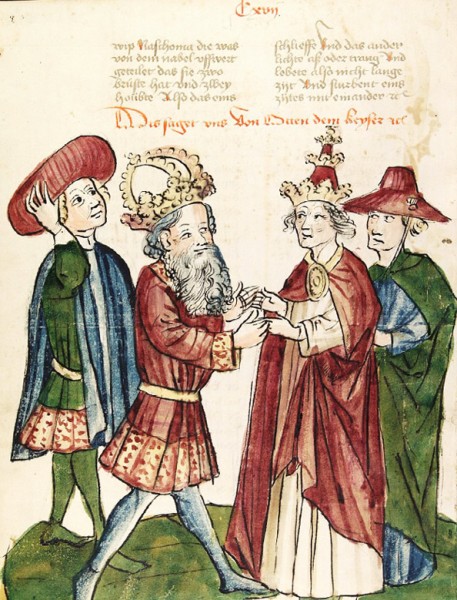
Meeting of Otto I and Pope John XII (after a drawing about 1450), pic. Wikipedia
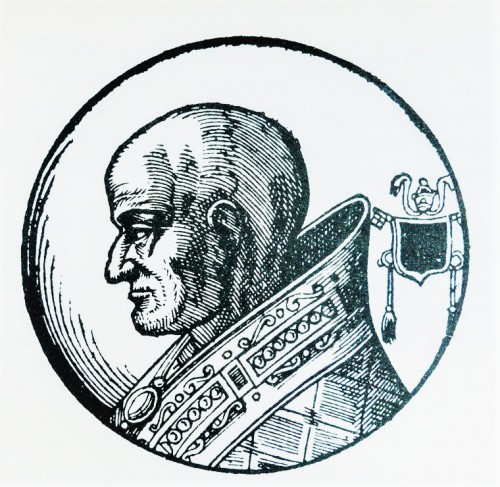
Pope Sergius III, figure from Le vite dei pontifici, 1710, Bartolomeo Platina
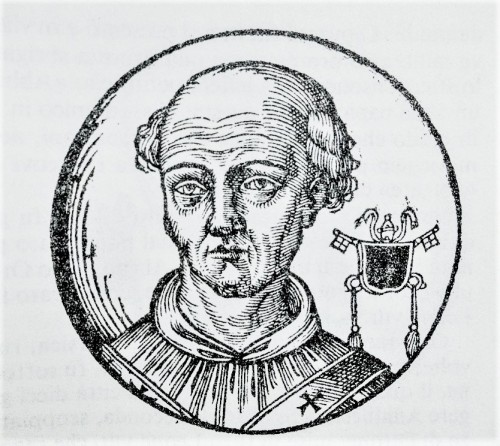
Pope John XII, figure from Le vite dei pontifici, 1710, Bartolomeo Platina
As early as ancient times we encounter chroniclers, who dependent on a given ruler, described the histories of his predecessors in a biased and one-sided way. Their protectors were shown in these descriptions as saviors, conquerors of evil, which was identified with the portrayed enemies. However, it seldom happened that the wickedness imputed to a certain adversary would stretch to generations which preceded him – his whole family or dynasty. Propaganda, for that is the name we should give to such writing, was therefore, nothing new in the X century, yet its means were intensified to an unseen before degree, almost preposterous. And it is almost difficult to believe that the illiterate Otto I, who was the principal and the protector of Liutprand of Cremona, recognized and was able to appreciate the power of the written word which came out from under the chronicler’s pen. If that was not enough this power is still felt today.
As early as ancient times we encounter chroniclers, who dependent on a given ruler, described the histories of his predecessors in a biased and one-sided way. Their protectors were shown in these descriptions as saviors, conquerors of evil, which was identified with the portrayed enemies. However, it seldom happened that the wickedness imputed to a certain adversary would stretch to generations which preceded him – his whole family or dynasty. Propaganda, for that is the name we should give to such writing, was therefore, nothing new in the X century, yet its means were intensified to an unseen before degree, almost preposterous. And it is almost difficult to believe that the illiterate Otto I, who was the principal and the protector of Liutprand of Cremona, recognized and was able to appreciate the power of the written word which came out from under the chronicler’s pen. If that was not enough this power is still felt today.
Liutprand himself came from Pavia and was an educated aristocrat with Longboard roots. Initially he stayed at the court of Hugh of Arles, then King Berengar II, and it was there – due to some unspecified reason – that he fell out of good graces (in the middle of the X century), finding himself at the court of his political adversary – the Saxon Duke and German King, Otto I. At that time, still a deacon, he began working on a six-volume chronicle Antapodosis (958-962). It concerned the events taking place in the then Europe after the death of Charlemagne until the coming to power of the aforementioned Berengar II. The author also tells of his legation to Constantinople. In this work, whose title can be translated as, The Retribution, the chronicler’s temperament is gradually replaced by ridicule, when Liutprand approaches contemporary times. In a tone that is somewhat satirical, somewhat filled with piquant anecdotes, a work that this not free of comedic aspects, overheard rumors and malice, he writes among others of the greed of his previous protector Berengar II and his wife Villa as well as their limitless tyranny.
Well-versed in Greek and possessing an excellent command of the pen, funny, sometimes spiteful, the courtier of Otto I, quickly acquired his respect. The king entrusted him with proofreading his texts and participation in diplomatic missions. Liutprand, in the meantime, elevated to the status of bishop of Cremona, departed with him to Italy, where he most likely took part in the coronation of Otto I as the Emperor of the Holy Roman Empire (962) and the dethronement of Pope John XII, and was also able to witness firsthand the perturbations on the papal throne, which occurred after the death of the latter (Benedict V, Leo VIII, John XIII). The result of these experiences was a work focusing on papal issues, Historia Ottonis (approx. 964). The brunt of the criticism of the chronicler fell upon the shoulders of John XII as well as the family of the lords of Tusculum (which until then had held power in Rome). Their history was presented in a biased and filled with aversion way bordering on scorn. Why? They were the principal adversaries of the newly elected Emperor Otto I, who wanted to introduce his new order in the city on the Tiber. The clever Liutprand of Cremona concentrated, in an almost obsessive way on the description of the grandmother and great-grandmother of Pope John XII (Theodora the Elder, Marozia) and their indecent deeds. In this way the men from the Tusculum and Crescentii families were also discredited, shown as pawns in the hands of the powerful, soulless and promiscuous women (pornocracy). This way of narration was to question the legitimacy of their authority, both secular as well as papal. Let us recall something, which may seem insignificant to us, the genealogical roots of John XII went all the way back to Charlemagne, while Emperor Otto I came from an insignificant at that time family of Ludolfingers. Active women and easily controlled, weak men were worthy of the utmost criticism and that was the propaganda goal which the silver-tongue Liutprand of Cremona set for himself, following the retinue of Otto “to conquer” Italy”. His knowledge of ancient authors allowed him to enrich his message with witty remarks and anecdotes, but it also carried with it another important borrowing – calumny (sodomy, incest, sexual relationships with mother, with the aim to discredit one’s adversary).
As it would turn out, his message, in which the emperor is an embodiment of all that is good and virtuous, while the pope of all evil and degeneration, fit it very well with the reformative Cluny movement within the Church, coloring the perception of papacy from that time for centuries to come.









